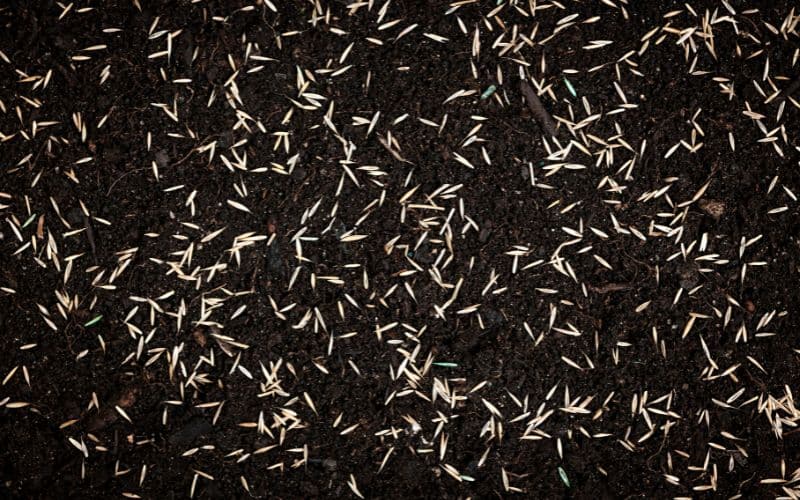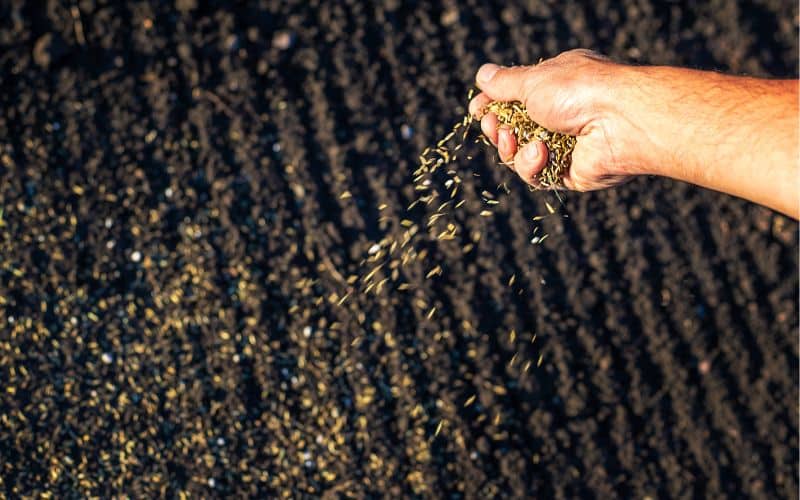
Growing a lush, green lawn from grass seed can be a rewarding process, but it’s not without its challenges. One of the most common questions that gardeners ask is, “How long does it take for grass seed to grow?” The answer to this question depends on several factors, including the type of grass seed you’re using, the conditions in which you’re planting, and how you care for the seed after it’s been sown.
Understanding Grass Seed Germination: What Does It Mean?
Germination is the process by which a plant grows from a seed. For grass seed to germinate, it needs to be in contact with moist soil, have access to light, and be in the right temperature range. The germination process begins when the seed absorbs water and swells. This triggers the seed to sprout, or germinate, and a new grass plant begins to grow.
Can Grass Seed Germinate on Top of Soil?
Yes, grass seed can germinate on top of the soil. In fact, it’s important not to bury the seed too deep as young grass shoots won’t be able to get through if there’s too much soil on top of them. However, the seed needs to be in contact with the soil to germinate effectively. This is why it’s recommended to cover your grass seed with a thin layer of soil or compost.
What Factors Influence How Long Grass Seed Takes to Grow?
The time it takes for grass seed to grow can vary widely depending on the seed variety and growing conditions. For example, Kentucky bluegrass typically takes 14 to 30 days to germinate, while Bermuda grass can germinate in as little as 10 days under optimal conditions. Factors such as soil temperature, moisture levels, and the amount of sunlight the seed receives can all impact the germination process.
How to Plant Grass Seed for Optimal Germination?
To give your grass seed the best chance of germinating, start by preparing the soil. Remove any weeds and loosen the soil with a rake or garden fork. This will create a good seed bed for the new grass seed to grow into. Next, spread the grass seed evenly over the soil surface. You can do this by hand for small areas or use a broadcast spreader for larger lawns. After seeding, lightly rake the area to mix the seed with the topsoil. This will help ensure that the seed is in contact with the soil, which is essential for germination.

The Role of Topsoil in Grass Seed Germination
Topsoil plays a crucial role in grass seed germination. It provides the seed with the nutrients it needs to grow and helps to retain moisture. If the topsoil is too compacted, the grass seed will struggle to germinate. Therefore, it’s important to loosen the soil prior to planting. If your topsoil is poor quality, consider adding soil amendments such as compost or a starter fertilizer to improve its nutrient content.
Choosing the Best Fertilizer for Your Grass Seed
Fertilizer can give your grass seed a boost and help it to germinate more quickly. Look for a starter fertilizer that’s high in phosphorus, as this nutrient is essential for root development. Apply the fertilizer according to the package instructions, and water it in well to ensure that the nutrients are available to the grass seed.
Does Grass Seed Need to Be Buried to Germinate?
While grass seed does need to be in contact with the soil to germinate, it doesn’t need to be buried. In fact, burying the seed too deep can prevent it from germinating. Instead, aim to cover the seed with a thin layer of soil or compost. This will help to keep the seed moist and protect it from being eaten by birds.
How to Prevent Grass Seeds from Being Washed Away?
One of the challenges of planting grass seed is preventing it from being washed away by water runoff or wind. To prevent this, consider covering the seeded area with a thin layer of straw or mulch. This will help to keep the seed in place while it germinates. Just be sure not to apply the mulch too thickly, as this could prevent the grass seed from receiving enough light.
Warm-Season Grass vs. Cool-Season Grass: Which is Best for Your Lawn?
The best type of grass for your lawn depends on your climate. Warm-season grasses, like Bermuda grass, thrive in hot, dry conditions, while cool-season grasses, like fescue, do well in cooler temperatures. Choose a grass variety that’s well-suited to your local climate for the best results.

Common Mistakes When Planting Grass Seed Uncovered
One common mistake when planting grass seed is failing to keep the seed moist. Grass seed needs to be kept moist at all times in order to germinate. If the seed dries out, it won’t be able to sprout and you’ll get poor results. Another mistake is not preparing the soil properly before seeding. Loosening the soil and adding amendments can greatly improve your chances of success.
Final Thoughts: Ensuring Your Grass Seed Grows Successfully
Planting grass seed can be a rewarding process, but it does require some patience and care. By choosing the right grass seed for your climate, preparing the soil properly, and caring for the seed after it’s been sown, you can grow a beautiful, lush lawn from seed.
Key Points to Remember:
- Grass seed can germinate on top of the soil, but it needs to be in contact with the soil and kept moist.
- The time it takes for grass seed to grow can vary widely depending on the seed variety and growing conditions.
- Preparing the soil properly before seeding can greatly improve your chances of success.
- Fertilizer can give your grass seed a boost and help it to germinate more quickly.
- Covering the seeded area with a thin layer of straw or mulch can help to prevent the seed from being washed away.
- It’s important to choose a grass variety that’s well-suited to your local climate.
- Keeping the seed moist at all times is crucial for successful germination.
Colin Macmillan is a seasoned entrepreneur and the CEO of Riverwood Landscape, a leading landscaping company based in Canada. He has been at the helm of the company since leaving high school, demonstrating his strong leadership skills and business acumen.
Colin’s expertise lies in various aspects of landscaping, including lawn care, interlocking, sod installation, and commercial maintenance. His hands-on approach and dedication to the craft have been instrumental in building Riverwood Landscape into a reputable brand.
One of his most notable achievements is the creation of a successful landscape franchise that services multiple locations. This accomplishment underscores his strategic thinking and ability to scale operations effectively.
Colin has also had the privilege of working with Guelph Hospital for landscaping and maintenance, a testament to the trust and reliability that his company has earned over the years.
His professional mission is to offer the best services and experiences for customers, a goal that he tirelessly pursues. Colin’s commitment to excellence and customer satisfaction continues to drive the growth and success of Riverwood Landscape.








